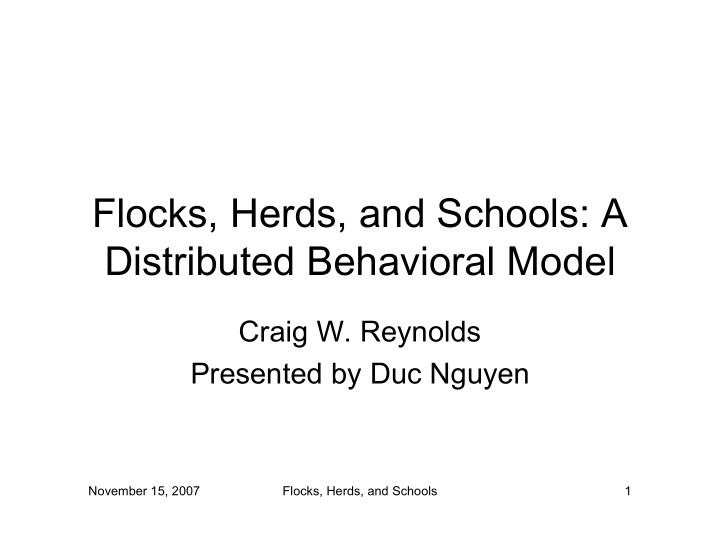



Flocks, Herds, and Schools: A Distributed Behavioral Model Craig W. Reynolds Presented by Duc Nguyen November 15, 2007 Flocks, Herds, and Schools 1
Simulated Flocks Boids • Simulate motion of flocks of birds or animals using individual behaviors • Elaborates on a particle system • More realistic than scripting the paths of the individual birds November 15, 2007 Flocks, Herds, and Schools 2
Prior work • Eurythmy – Flocking simulations used force-fields around each bird and around each object. – The animator sets the initial positions, headings, and velocities. • Other behavioral control work by Karl Sims was based around groups of single objects, not flocks. November 15, 2007 Flocks, Herds, and Schools 3
Particle Systems • Particle Systems are collections of large number of particles each with their own behaviors. – As of the time of the paper, they were used to model fire, smoke, clouds and ocean waves. • Boid flock system is a generalization of a particle system November 15, 2007 Flocks, Herds, and Schools 4
Geometric Model • Each boid uses an accurate geometric model for flight – Incremental translations along current path – Calculates each translation once per frame • Higher sampling rate refines the shape of motion. November 15, 2007 Flocks, Herds, and Schools 5
Simulated Flocks • Create a boid model that supports geometric flight • Add individual behaviors that oppose each other: – Separation – Alignment – Cohesion – Obstacle Avoidance • The boids must be able to arbitrate conflicting behaviors as well. November 15, 2007 Flocks, Herds, and Schools 6
Simulated Flocks: Separation • Avoid crowding local boids November 15, 2007 Flocks, Herds, and Schools 7
Simulated Flocks: Alignment • Steer toward the general heading of the rest of the flock November 15, 2007 Flocks, Herds, and Schools 8
Simulated Flocks: Cohesion • Move toward the average position of local flockmates. November 15, 2007 Flocks, Herds, and Schools 9
Avoiding Obstacles • Independently model the shape for rendering and collision avoidance. • Boids model uses a steer-to-avoid as opposed to force- field concept. November 15, 2007 Flocks, Herds, and Schools 10
Putting it all together • Simulated Flocking behavior that mimics real life flocks and herds. – When combined with low priority goal seeking results in a scripted path of the flock. November 15, 2007 Flocks, Herds, and Schools 11
Conclusion • Boids is a model of non-colliding motion of flocks based on simulating behavior of individual boids. • Boid model is an example of emergent behavior – Simple local rules lead to complex global behavior • References – http://www.red3d.com/cwr/boids/ – Paper: http://www.cs.toronto.edu/~dt/siggraph97-course/cwr87/ November 15, 2007 Flocks, Herds, and Schools 12
Recommend
More recommend